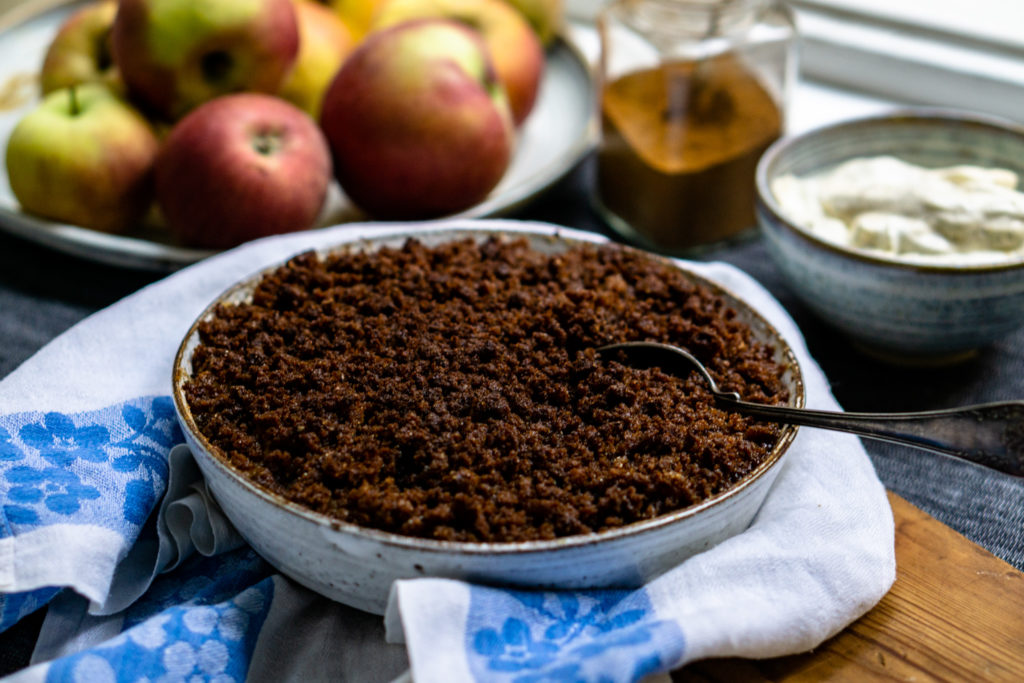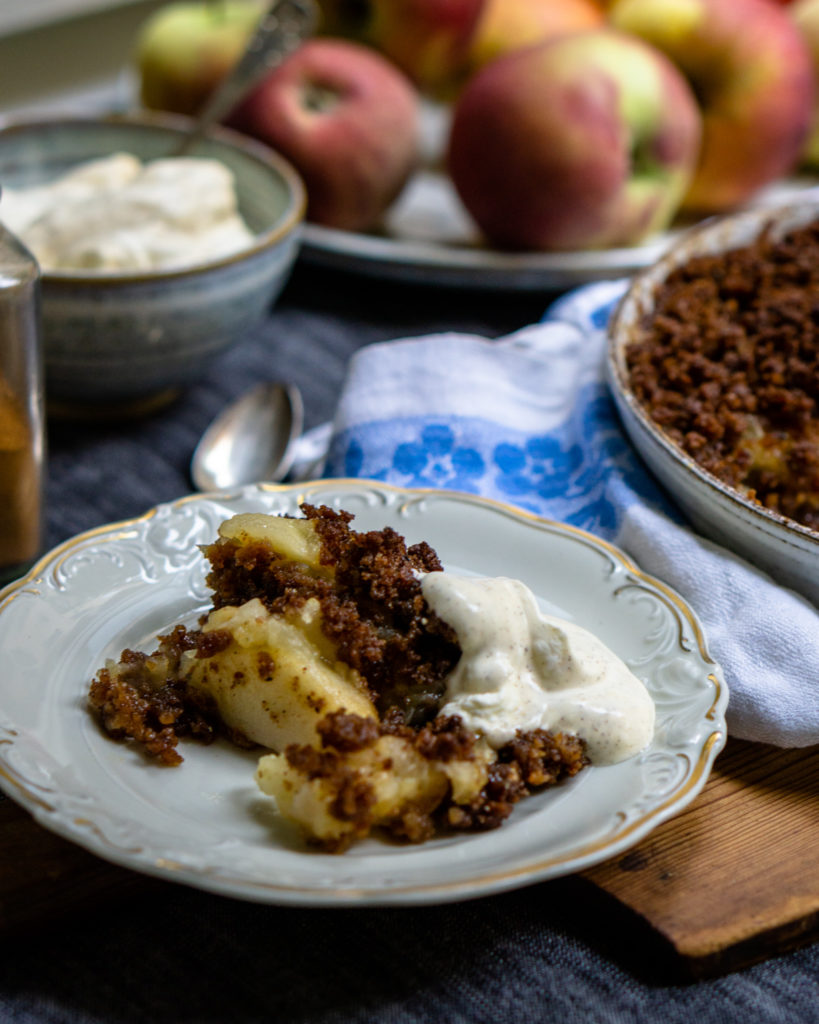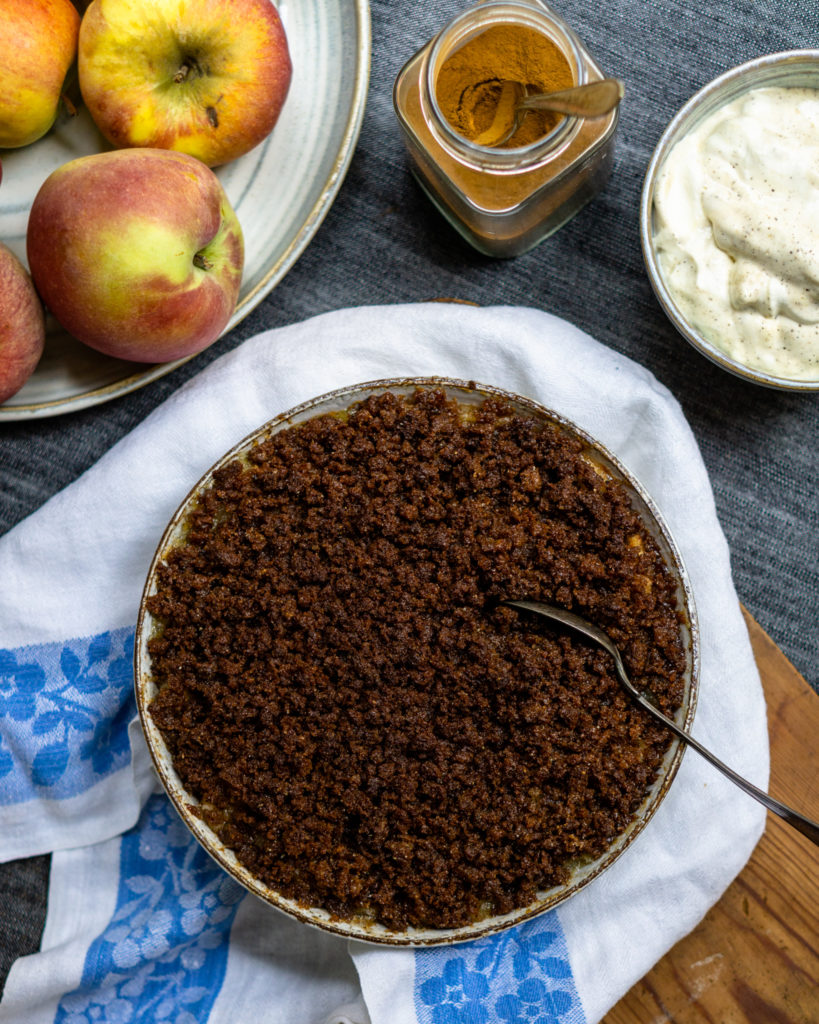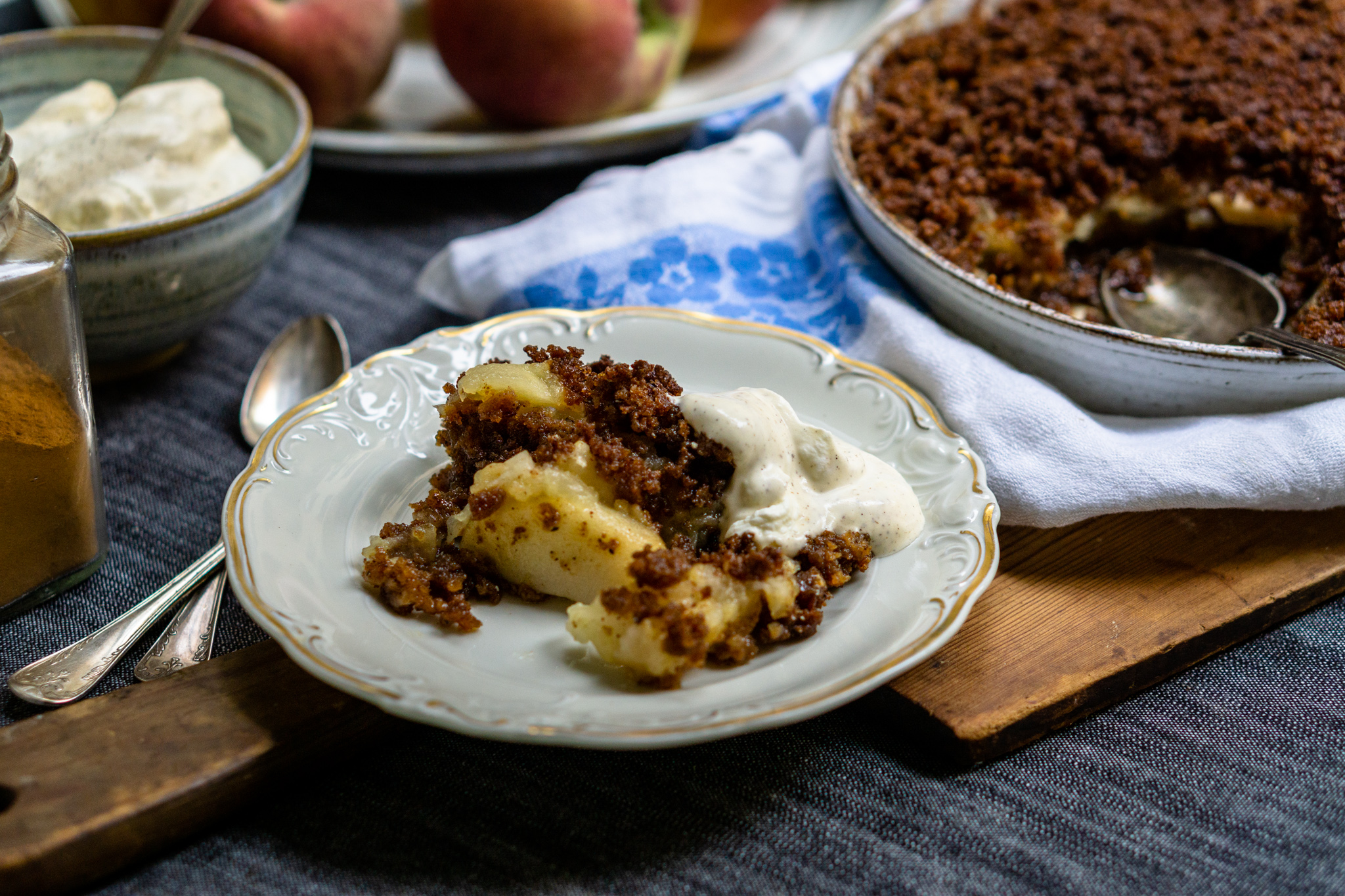To continue the theme of sturdy dishes from the south of Sweden, let’s turn to Scanian apple cake, or skånsk äppelkaka.
The idea of frying flavorful grated rye bread in browned butter and layering it all with a cinnamon-scented apple compote… it sounds too good to pass up! It wasn’t until recently that I tried this dish for the first time, but it was a hit from the first bite. The dish isn’t particularly complicated or time-consuming to make, either — a real win. Plus, what better way to use up slightly stale bread?
I’d not recommend enjoying skånsk äggakaka and skånsk äppelkaka at the same meal, though, unless you’ve got plenty of self-discipline when plating the portions…
Skip straight to the recipe for Scanian apple cake by clicking here.
The history of Scanian apple cake
What’s so Scanian about Scanian apple cake, or skånsk äppelkaka? That’s a very good question.
Nowadays, the dish is connected to the Scanian celebration on the tenth of November, which is in honor of the French saint, St Martin of Tours, who has “his” day on the 11th. This celebration is known as Mårtensafton, or Mårten Gås, “Mårten Goose”. Back in the days, this day marked the start of the 40-day long lent period preceding Christmas in Sweden, but the tradition survived mainly in Skåne, Scania.
As you may guess from the name Mårten Gås — the Scanians’ celebrate the festivities by eating goose! This apple cake is the feast’s traditional dessert, although its inclusion apparently is due to the Stockholm restaurant Piperska muren in the 1850s. However, the Scanians happily adapted the apple cake dessert. To add further to the Scanian connection, the apple cake is often made using bread crumbs from the rye bread called kavring, which has a very strong connection to this southern county.

Swedish apple cake eating, from the 18th century and onwards
Before this cake was Scanian, it was definitely Swedish — this type of apple cake based on bread crumbs goes way back.
In Maria Elzberg’s 1751 cookbook, there are several apple cake recipes, and two of them are similar to today’s recipes as they use sötsur limpa — what could be translated as sourdough bread. The recipes both feature sliced apples rather than grated apples.
The first cake layers breadcrumbs with an apple mixture sprinkled with cinnamon, sliced succade (citrus peel), and currants. The second alternative fries grated bread in melted butter to make a bottom and topping of the cake, which is filled with “stewed apples”.
Cajsa Warg’s famous cookbook from 1755 features a recipe called rifwen äple-kaka — grated apple cake. Her cake consists of grated apples and sugar layered with breadcrumbs and melted butter. The bottom and top layers are made of buttered breadcrumbs and you top off the cake with a little wine before you bake it.
Apple cakes in the 19th century
If we skip a century ahead, Gustafwa Björklund includes several apple cakes in her 1847 cookbook, with a couple of them looking similar to today’s Scanian apple cake: äpplekaka med surt bröd — apple cake with sour bread — and äpplekaka af omogen frukt — apple cake of unripe fruit. Both recipes feature apple slices that are layered with buttered, sweetened breadcrumbs.
Charles Emil Hagdahl’s 1897 cooking bible features two Swedish and two German apple cakes. I have some trouble telling them apart — they all feature grated bread, although it is specified that you need a coarser bread like rye bread for one of the German cakes. The German cakes use apple sauce while the Swedish ones use sliced, or lets you choose The German apple cakes feature more extras — currants, or cinnamon, cloves, and lemon peel.
20th century — the apple cake turns Scanian?
The first mention of Scanian apple cake in the newspaper Svenska Dagbladet is from 1926, although there’s no recipe for verifying the ingredients and cooking method.
In Prinsessornas kokbok from 1934, there’s a Swedish, a Scanian, a Norwegian, and a French apple cake. The two latter are completely different beasts, but the Swedish and the Scanian apple cakes are similar. However, it’s the Swedish version that features a coarse bread, “preferably a sweet-sour, spiced savory bread“, while the one from Skåne uses crushed husks.

Different ways of making Scanian apple cake
A pamphlet titled Skånsk äppelkaka — recept och historik kring en traditionell rätt med många varianter from Skåneländska Gastronomiska Akademien turned out to be a real treasure trove.
It features the advice of renowned pastry chef Jan Hedh, who is from Skåne, as well as apple cake recipes from some of the best restaurants in Skåne. Hedh reminisces on his mother’s preparations for celebrating Mårten Gås, but also shares his recipe, where he uses a mix of kavring and breadcrumbs for the base. The chefs at the Grand Hotel in Lund, Grand Hotel Mölle, Vellinge Gästis, and Årstiderna follow Hedhs approach, while the rest use only breadcrumbs or only kavring.
Karlaby Kro stands out by cooking the apples in a sugar syrup flavored with green pepper — otherwise cinnamon is the normal flavoring, although Margaretetorps Gästgifvaregård uses cardamom and ginger as well. A couple of places use farinsocker, brown sugar, instead of granulated sugar to sweeten the crumbs.
Brösarps Gästgifveri & Spa just slices the apples, but the other places either use a combination of apple sauce and sliced apples or make an apple compote.
Hedh prefers the type of apple called Cox’s Orange, but also recommends Gravensteiner, Ribston, Belle de Boskoop, and Cellini. Other apple types favored by the restaurants include Karmijn, Aroma, and Ingrid Marie. As apple varieties vary so much depending on where you live, use whatever apple you like. However, it’s a good idea to see the amount of sugar in the recipe as a guideline and adjust it based on the apples, especially if you use a very sweet or very tart variety.

How to make a Scanian apple cake
You don’t have to use kavring bread to make the cake! However, using sourdough or rye bread, a lighter bread, or breadcrumbs can change the flavor somewhat — adjust the seasoning with spices until it is to your liking.
For the apple filling:
8 medium-sized apples
1 dl (2/5 cups) water
1 dl (2/5 cups) sugar
lemon juice from 1 lemon
optional: 1/2 tsp ground cinnamon
For the bread crumble:
10-12 slices of kavring rye bread or similar (it’s okay if it is a few days old)
150g (2/3 cups) butter
2 tsp ground cinnamon
2 tsp ground ginger
2 tsp ground cardamom
1 dl (2/5 cups) sugar
To serve:
vanilla ice cream, custard or råkräm, see recipe below
- Set the oven to 200°C (390°F). Choose a pie dish or other oven-proof dish and have it ready — no greasing necessary.
- Make the apple compote by peeling the apples, removing the cores, and slicing the apples into slices. Add the slices to a large pot together with the water, sugar, and lemon juice. Add a little cinnamon if you want a stronger cinnamon flavor. Heat it all on medium heat until the apples begin to soften. Remove the pot from the heat. Gently mash the apples a little — I prefer a bit of apple sauce with many larger slices still somewhat intact.
- Make the bread crumble by cutting off the crust from the bread slices. Chop them into large pieces and run them in a kitchen mixer until they turn into fluffy crumbs. Alternatively, you can grate the slices on a grater. All in all, you’re looking for about 6 1/2 dl (about 2 2/3 cups) of crumbs.
- Melt the butter in a frying pan. I like to brown it for extra flavor, but that isn’t necessary — just make sure it is melted and doesn’t burn. Add the crumbs to the butter, together with the cinnamon, ginger, and cardamom. Stir until the butter, crumbs, and spices are well combined. Fry the crumbs for a few minutes, then stir in the sugar. Continue stirring and frying the crumbs until they start to dry, but be careful not to have the temperature too high as the sugar might burn.
- Add half of the crumbs to the bottom of the pie dish. Flatten them with a spatula so they become an even layer. On top of the crumbs, add the apple compote and smoothen it out. Then, top the compote with the rest of the crumbs.
- Bake the dish in the oven for about 20-25 minutes, until the crumbs have dried out a bit — be careful so it doesn’t burn.
How to make Swedish raw custard — råkräm
This is a sauce you whip up just before serving — or a couple of hours in advance, tops. The reason for that is that it uses raw yolks. In Sweden, raw eggs are generally considered safe, but please only do so if it is considered safe where you live, too. Regardless, you want to use high-quality eggs.
2 dl (4/5 cups) whipping cream
2 yolks
1 tbsp powdered sugar (or granulated)
1/2 tsp vanilla powder
- Whip the cream until it is firm.
- Stir the yolks, powdered sugar, and vanilla together until it is well blended.
- Pour the yolk mixture on top of the cream and gently fold it in. Don’t blend it into an even mixture — instead you want beautiful swirls of vanilla in the cream.
- Ideally, you’ll serve it immediately, but you can store it in the fridge for a couple of hours if necessary.
Suggestions
You can serve the apple cake however you like — with ice cream, custard, or whipped cream — that’s all nice, but my favorite is the råkräm above. A dollop of crème fraîche is a fresh alternative.
Don’t have kavring bread? Bake it! Or, just use any rye or sourdough bread, or even a lighter bread. The taste will vary with the bread, so you may need to adjust the seasoning.
You can use store-bought breadcrumbs, too — ideally, you want them fluffy instead of the “sawdust” variety, but they’ll work fine, too.
For a rustic serving style, fry the crumbs in a cast iron pan and bake the apple crumble in the same pan. You can also bake this crumble in individual ramekins — just make sure to shorten the baking time and check on them, so they don’t burn.



0 Comments